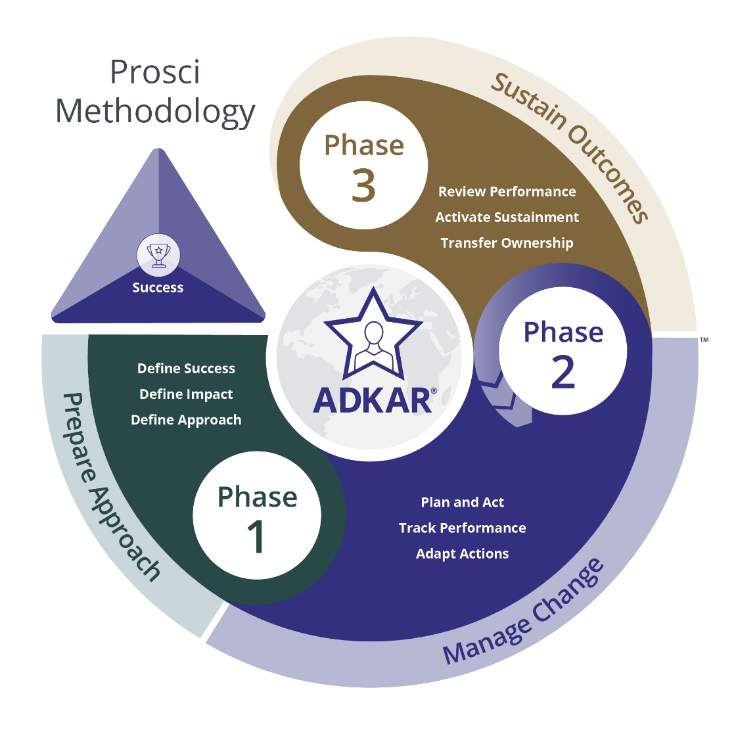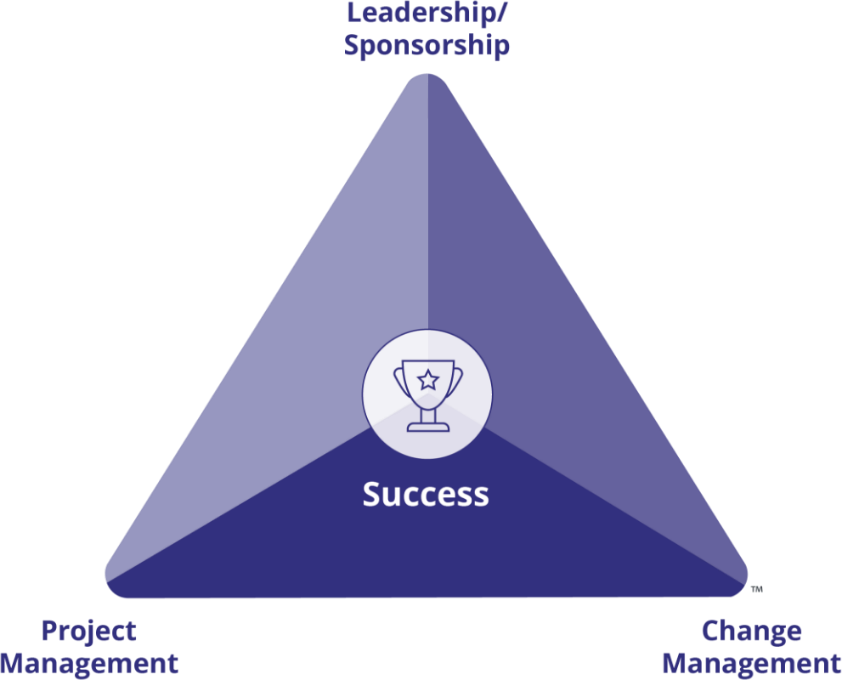Change Management
Change Management is the discipline that prepares, equips and supports individuals and teams moving through organisational changes so that they successfully adopt the changes.
Change Management is the discipline that prepares, equips and supports individuals and teams moving through organisational changes so that they successfully adopt the changes.
Organisational change occurs through the implementation of projects and transformation programs aimed at achieving strategic objectives, which results in business benefits.
But merely completing project deliverables does not lead to realising those benefits. Employees must fully embrace, adopt and engage with the change for that to happen.
Leadership teams often overlook that last aspect. That is why 70% of organisational change projects fail.
It is a simple rule: without adoption, changes will not materialise as intended and will fall short of the expected business benefits.
Change Management is the solution.
Change Management empowers organisations to proactively address the impact of change on their workforce while ensuring the full realisation of its benefits.
Change Management can be applied to a wide range of changes, including technological changes, process improvements, mergers and acquisitions, IT systems implementation, business process engineering projects, and significant culture transformation projects … to name of few.

Change Management means managing the people side of change.
When change occurs within an organisation, it is crucial to recognise the significant role that people play in achieving the intended results. Change often entails requesting them to approach and perform their job in new ways, either entirely or partially.
Prosci emphasises that managing change is a dynamic process which is based on the following 5 core tenets:
Simon Sinek has demonstrated that the initial catalyst for people to embrace change is rooted in having a compelling reason to do so.
The true game changer for any change initiative to thrive lies in the leadership team's ability to provide a shared sense of purpose, direction and meaning.
As change impacts job performance, it implies acquiring and applying new skills to effectively adapt to new working methods.
Change might include adopting new behaviours, using new systems, implementing new procedures, and embracing new values or corporate culture.
Although the step process is the same for everyone, each person executes the transition differently.
Leaders often fall into the trap of assuming that individual change will effortlessly occur by itself. That is a big mistake.
Jeff Hiatt, Prosci's founder, emphasised more than twenty years ago that change is an individual phenomenon. This insight led to the development of the renowned ADKAR® Model.
Successful change is the sum - and synchronisation - of all individual transition paths. It means that each individual has transitioned from their old work habits to new ones, defined as the expected outcome of the change.
No transformation can truly be considered complete until each individual involved has successfully undergone their own personal transition.
This is where Change Management - defined as a structured, b and tool-based approach - comes into play.
The Prosci Change Management Methodology offers a structured and tool-based approach to assist employees in transitioning through a change. It involves developing and implementing plans of activities in four key areas:
The Change Manager will create comprehensive plans for activities in the abovementioned areas, working closely with leaders, executives, people managers, and employees to ensure effective execution and progression of each employee towards the future state.
Change always has two faces:
Change is a project and should be managed as such to deliver the technical solution: the software, the new process, the merger, the new culture, the new offices, the new way of working, the move, etc…
This is the core focus and mission of Change Management.
As Prosci's benchmarking studies show year after year, organisations that apply effective Change Management are seven times more likely to meet the project's objectives.
Managing organisational change is a dynamic three-phase process. It starts quite logically with a preparatory phase, paving the way for an impactful execution phase, and culminates with a critical sustainment phase to ensure long-term success.
In the Prosci Methodology, each phase is further divided into three stages, encompassing a range of significant activities.

For more than 20 years, Prosci has been surveying thousands of change practitioners worldwide, building the largest body of knowledge and best practices available.
Without a steep learning curve, you can dive right in and apply them immediately.
to any kind of organisational changes (IT, culture, merger, process, …).
to fit the unique needs of every change initiative.
The success of a change initiative relies on how you manage the following 4 aspects:
 |
Success definition: You need to clarify why the change is required, the project objectives, and the expected business benefits.
Leadership/Sponsorship: Without active and visible sponsorship providing constant direction and guidance towards the future state, there is no successful change.
Project Management: Any change is a project, and any project leads to a change. That is why effective Project Management is another key success factor of any change initiative. It ensures proper design, development, and delivery of the solution - what we call the technical side of the change, regardless of its nature.
Change Management: This discipline is specifically applied to address the people side of the change, assisting employees in embracing and effectively utilising the (technical) solution.
|
 |
|
| Within the Prosci toolbox, the second most important tool is the PCT Model. This robust framework empowers leadership, Project Management, and Change Management teams to align and embrace a unified perspective on the overall health of the change project. Covering these four fundamental aspects enables seamless collaboration and ensures success at every step of the journey. | |
There are 3 different scenarios:
Become a Change Manager
You have been entrusted with managing the people side of a project and are seeking to enhance your Change Management skills. Our 3-day certification program is the perfect starting point for you.
Get trained
Not only will you obtain certification in the industry-leading Change Management Methodology, but these three days of dynamic training will empower you to implement the method immediately upon completion.
It also gives you access to the Prosci toolkit for one year and the knowledge base and best practices that will allow you to guide your projects and benchmark them.
In addition, the certification gives you credits recognised by the ACMP and PMI.
Develop your organisation's ability to respond agilely to change
Developing this leadership competency requires crafting a tailored plan that aligns with your organisation.
Embarking on this journey begins with an exploratory meeting where we can discuss your specific needs.
Let's connect and explore how we can help
Get support for a project
In addition to our Change Management training activities, our team of skilled consultants is well-versed in various business scenarios. They can join forces with you as external resources, supporting your journey until you master the necessary skills internally (which is always the end goal of our assignments).
Let's connect and explore how we can help
Change Management: Results With and Without. A Case Study.
Prosci Europe's case studies offer practical insights for organisations wishing to make changes that stick. Executive Summary Why should I read? To get a real-life example of what can happen without a structured approach to managing the change. We uncover the difference in outcome between two organisations seeking to deploy the same technological solution to a recurrent and common issue in the personal care service sector. Highlights: In one case, the implementation phase proved much longer than expected. Only half of the staff was or stayed on board. The gulf between the target set and the number of people proficiently using the change kept widening every day. The second case shows adoption and utilisation rates close to 88%. A clear CM plan with actionable strategies delivered expected results on time. For a complete overview of what a successful CM plan looks like, please see Keys to application. ...
Written by
Nelly Tire and Vincent Piedboeuf
Moving to the Hybrid Workplace: How ADP and Otis Managed the Change.
The move is having a significant impact on corporate culture, and it is full of human challenges. In both cases, Awareness and Desire are key components and drivers of the change process. The context, nature of the change and approaches adopted create a fertile ground for Enterprise-wide Change Management (ECM) development. Executive Summary The process of hybridisation involves the shift to remote working and, in some instances, the creation of a flex office. We have conducted interviews with Otis and ADP to get the big picture and understand how they deal with the change(s). 1. Sponsors can make or break the change, but sponsorship deficiencies are quite common. The case of ADP highlights the role of CM practitioners, not as substitutes to leaders in sponsoring the change, but as enabling forces. While CM experts lack proper authority or proximity to the field, a close working relationship with ...
Written by
Renaud de Lombaert
This is how they used Change Management to shift mindsets and succeed.
Executive Summary Prosci Europe's case studies offer practical insights for organisations wishing to make changes that stick. Why should I read? Type of change. Against a backdrop of a corporate merger, this IT-driven change involved the implementation of a new operating model (TOM) whose effectiveness largely depended on mindset shifts. An exciting case study packed with human challenges that teaches a lot about how Change Management can create a fertile ground for adopting new processes, roles and behaviours. What success looks like. In the IT department, where many efforts went into preparing and managing the change, results show a massive difference in terms of adoption and engagement compared to the rest of the organisation. An engagement survey conducted before CM solutions were deployed suggested a modest progression in only 4 out of 11 categories under scrutiny. A second mirror survey carried out at the ...
Written by
Pauline NAVEAU et Vincent PIEDBOEUF
Building Change Management Capabilities For Massive Change.
Executive Summary Dive into a compelling real-life example that showcases how to drive a large-scale transformation, simultaneously generating quick wins and setting the groundwork for deep-seated, sustainable change. Learn about the different layers of a balanced and holistic CM strategy. This case study provides timely insight into how one large medical organisation is transforming its (infra)structure, processes, and day-to-day operations to become a next-generation entity within its sector. Highlights: How would you handle a large-scale transformation? This project will impact 4500 people, with more than 150 projects rolled out over five years. The journey begins with no preexisting CM resources. Please keep in mind that this transformation is still ongoing. NEXUM is building Change Management organisational capabilities from the ground up. We are taking it from ‘ground zero’ all the way up with a comprehensive strategy that focuses on establishing robust internal governance ...
Written by
Antoine Wouters